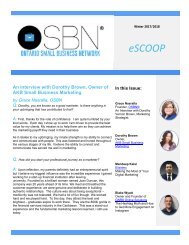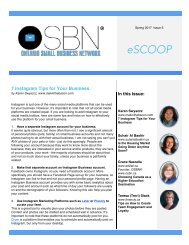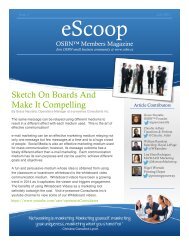eScoop -Issue 4 - Fall 2016
Sharing stories of expertise from OSBN® members.
Sharing stories of expertise from OSBN® members.
Create successful ePaper yourself
Turn your PDF publications into a flip-book with our unique Google optimized e-Paper software.
<strong>Fall</strong> <strong>2016</strong> <strong>Issue</strong> 4<br />
eSCOOP<br />
5 Reasons Why Small Business Owners Need<br />
To Join A Small Business Community<br />
by Grace Nasralla, OSBN<br />
1. Build A Network of<br />
Connections<br />
Small businesses cannot survive on<br />
their own. In every business most<br />
sales is done through word of mouth<br />
or referrals from people that have<br />
established trust in the business or<br />
the owner of the business. Building<br />
a network of connections results in<br />
getting leads that may turn into<br />
customers or that may send<br />
customers to a business.<br />
2. Learn Best Practices<br />
Business community websites are<br />
filled with information that is of<br />
importance to the small business -<br />
from how to start a business to the<br />
latest trends in business. Business<br />
communities are a great resource to<br />
gain knowledge about how to’s and<br />
where to’s for growing a business.<br />
Whether it be through forums or<br />
group discussions or just postings<br />
on a profile timeline, there is always<br />
something to learn and gain<br />
knowledge from.<br />
3. Stay Motivated<br />
Being a part of a small business<br />
community will definitely help<br />
motivate a business owner.<br />
Entrepreneurs tend to lack<br />
motivation at times as they are<br />
responsible for doing all business<br />
tasks.<br />
At times they may get overwhelmed<br />
with tasks and lose motivation while<br />
at other times, they may feel they<br />
have run out of ideas and lose<br />
motivation to continue.<br />
A good way to stay motivated is to<br />
find a professional business<br />
community and stay active there.<br />
Stay connected with business<br />
owners on the network, attend<br />
community networking events, stay<br />
visible by placing ads or taking up<br />
speaking engagements during<br />
events, and always offer to help.<br />
That will not only keep a business<br />
owner motivated, but it will also<br />
increase business visibility within<br />
the community.<br />
4. Generate Leads<br />
Business leads come from knowing<br />
people. Meeting people requires a<br />
community. Look for business<br />
communities that have a virtual<br />
platform and that also run events.<br />
That way one will get to meet<br />
people and then stay connected<br />
over the internet to send leads and<br />
referrals.<br />
One thing business owners have to<br />
remember: in a community one has<br />
to give in order to take. Give leads<br />
and others will send you leads, give<br />
referrals to other business members<br />
and others will send you referrals.<br />
In this <strong>Issue</strong>:<br />
Grace Nasralla<br />
Founder, OSBN®<br />
www.osbn.ca<br />
5 Reasons to Join a Small<br />
Business Community<br />
Christine Boyle<br />
www.FusionEnterprises.ca<br />
Discovering the “Buy”<br />
Button – Neuromarketing:<br />
The Cutting Sales Edge<br />
Daryl Landeau<br />
OSBN® Advisory Board<br />
Member<br />
www.common-ground.ca<br />
Getting the Most Out of an<br />
Advisory Board<br />
Teresa (Terri) Slack<br />
OSBN® Advisory Board<br />
Member<br />
www.financly.ca<br />
How Understanding<br />
Personalities ….<br />
Susan Kirschling<br />
www.susankirschling.com<br />
Belief
5. Enjoy Benefits<br />
Business community websites usually<br />
offer benefits to their members.<br />
Benefits may vary from free services<br />
to discounts and offers, access to<br />
business resources and more. Make<br />
use of these benefits! Many<br />
businesses register at business<br />
community websites and forget about<br />
their account. It’s good practice to visit<br />
business community websites often to<br />
explore new benefits added to<br />
members.<br />
Reptilian <br />
Brain<br />
Limbic <br />
System <br />
(Mammal <br />
Brain)<br />
Three <br />
Layers in <br />
the Brain<br />
Neocortex <br />
(Neo-‐‐<br />
Mammal <br />
Brain)<br />
The Reptilian Brain is the instinctive brain. It’s very basic and governs<br />
information like heartbeat, digestion and other body maintenance items, as well as<br />
survival. It also collects data, facts, and memory and processes this data, meaning<br />
there are not many interpretive, cognitive or emotional aspects working. This<br />
primitive part of the brain is prone to make snap, short-term decisions. You don’t<br />
want your prospects making purchase decisions with this information only. During<br />
her webinar in June 2015 on “Sell and Market Better with Neuroscience”, Christine<br />
Comaford, author of Smart Tribes, referred to this as “The Critter State” - a limited<br />
fact-based part of the brain,<br />
Discovering the<br />
“Buy” Button -<br />
Neuromarketing: The<br />
Cutting Sales Edge<br />
by Christine Boyle, Fusion Enterprises<br />
Scratching your head over why your<br />
prospect didn’t buy when you were so<br />
sure the sale was in hand? It is well<br />
known that customers decide with<br />
their emotions not their primitive factbased<br />
brain.<br />
How do you create an emotional<br />
sales process that motivates the<br />
buyer?<br />
Let’s jump into understanding Brain<br />
Basics then look at how it works and<br />
its importance in the sales process.<br />
Finding your tribe – your “peeps” – is within the Limbic System and is the<br />
emotional brain where people connect with one another, seek belongingness, look<br />
for alikeness, commonalities and mutual behaviours which in turn create trust. It is<br />
the sweet spot for building rapport, relationships and connection as it governs<br />
emotions (emotions are the predominate motivator when we make buying<br />
decisions) and perceptions and processes the data of the Reptilian Brain and<br />
Neocortex and decides how to respond to you.<br />
We evolve significantly in the Neocortex Brain. It is the advanced thinking area<br />
which involves planning, processing and interpretations like deciding if you are an<br />
enemy or friend and how to respond to you and it makes choices like fight or flight,<br />
preserve or protect and, without sufficient data about you, it defaults to negative<br />
assumptions and reactions such as a ‘no’ to the purchase.<br />
How do we incorporate Brain Basics or science into our sales process?<br />
Here is a sure-fire way to structure your sales presentation - Neuromarketing is<br />
brilliant, we actually work in reverse!<br />
Process of sales presentation:<br />
Limbic<br />
Neocortex<br />
Reptilian
The strongest appeal is to the Limbic System<br />
- Are you one of ‘me’?<br />
- Do we have similarities I align with and can belong to?<br />
- Have you built my trust and safety in my decision?<br />
- What is our emotional tie?<br />
Make emotional connections here. <br />
Feed the Neocortex Brain<br />
- Reduce anxiety and fear with information, planning and solving problems.<br />
Don’t ignore the Reptilian Brain<br />
- Include facts, stats and figures.<br />
The Reptilian Brain is the root of the decision process and now will also assess<br />
the Limbic System and Neocortex data to justify the purchase.<br />
Process of decision making<br />
Reptilian<br />
Neocortex<br />
Limbic<br />
Reptilian Brain makes the decision and assesses Neocortex and Limbic System<br />
data to justify the purchase. Give me the facts – is generally a defensive, anxious,<br />
risk-adverse and reactionary mindset.<br />
Neocortex Brain assesses friend/foe, safety/fear, is self-aware, thinks, evaluates,<br />
plans and problem solves.<br />
Limbic System is the root of emotions, connections, sameness and relationship.<br />
Discovering the “buy-button” is now easier as you appeal to the person’s<br />
three brain parts to create a powerful sales process.<br />
Perhaps you’ve been missing a component? Successful sales people no longer<br />
sell by pushing the client or by presenting two fact-based A/B options. Instead, we<br />
can leverage:<br />
- The knowledge of how people make decisions.<br />
- The science of the brain.<br />
- The complexities and emotions of the person.<br />
The human need for emotional connection, dispelling their fears and<br />
understanding why they need to make safe and sound buying decisions is<br />
key.<br />
I’d love to hear from you and welcome your stories, struggles and successes, and<br />
how you’ve added this cutting edge tool into your business.
Getting the Most out of an Advisory Board<br />
by Daryl Landeau, Common-Ground<br />
What is an advisory board?<br />
An advisory board is an informal version of a board of directors<br />
chosen by the owners.<br />
- It has no authority<br />
- It just offers assistance as requested.<br />
- It is a good interim step before a formal board, or a way for a<br />
founder to enhance accountability and experience.<br />
The Ideal<br />
The owner or leader explains the vision, values, strategic plan, and recent<br />
performance of the organization. The advisors pose questions about places<br />
where there might be a misalignment or gap or impracticality. "If your<br />
growth is X, and your resources are Y, how will you achieve your vision<br />
which is Z?" The leader poses questions to the advisors, like "What do you<br />
think should be the priority now?"<br />
The advisors don't take over decision-making, but they share opinions, or<br />
help the leader think things through. Meetings are conducted efficiently, not<br />
wandering on tangents. The advisors come from diverse experiences and<br />
are not deferential, so they don't fall into groupthink, but neither do they<br />
disrespect different opinions. Besides, not everything happens in the group<br />
meeting, sometimes individuals offer a bit of coaching or a useful<br />
connection outside of the 'board meeting.'<br />
Thus the organization benefits from better leadership. And the advisors<br />
benefit from the learning too; for some this is a stepping stone to a directorship.<br />
Making the Ideal Real<br />
In order to achieve this ideal, the owner needs to find the happy medium of<br />
openness: not arrogant, not fearful, but willing to be respectfully<br />
challenged. The advisors also must not be arrogant, and not too attached to<br />
their opinions. Better to offer ideas, or even better, pose open questions.<br />
These advisors, who ought to have considerable relevant experience, need<br />
to get informed enough about the particular business and the industry to be<br />
useful. And they need to work well with the other advisors.<br />
Usually a group of 4-6 is the best size for this purpose; enough to get<br />
diverse views and meetings are easily managed. The job of Chair, though<br />
often the leader's, may be better handled by a skilled facilitator/advisor (one<br />
who may have less to contribute substantively), and thus freeing the leader<br />
to focus entirely on the substance of the discussion. The discussions are<br />
informal and do not need the procedural (Robert's) rules that govern true<br />
board meetings.<br />
Owner/Leader:<br />
Vision<br />
Values<br />
Strategic Plan<br />
Recent Performance<br />
Advisors:<br />
Share Opinions<br />
Diverse Experiences<br />
Not Deferential<br />
Discussions:<br />
Informal<br />
Open<br />
Respectful<br />
Informed<br />
If OSBN® wishes to try this approach and finds it useful, I hope member<br />
businesses will also try it, perhaps with an exchange program with other<br />
members.
How Understanding Personalities Can Create<br />
Happy Customers and Happy Team Members<br />
by Teresa Slack, Financly<br />
I have learned over my many years of customer service delivery that the more I<br />
understand my client’s personality the better the interaction goes. Whether<br />
dealing with an upset client or trying to maximize a sales interaction, the more you<br />
reflect their personality style the more successful the interaction will be.<br />
There are many different personality profiling methodologies, whether colours,<br />
shapes or words, they all do the same thing. They allow you to understand your<br />
own personality more clearly and they teach you to identify other people’s<br />
personality traits as well. My profiling method of choice is the DiSC®. System.<br />
A keen focus on understanding another person’s personality will<br />
allow you to interact in a manner that creates a successful outcome.<br />
The trick is to quickly figure out the person you are<br />
talking to and change your approach to match their style.<br />
As a manager of a sales team, I taught my team to use personality profiles to understand each other and their<br />
customers. What I found is that my team had a better understanding of each other and why certain members of our team<br />
might clash due to personality differences. This knowledge created understanding and acceptance within the team. My<br />
dominant team members understood why our conscientious teammates rubbed them the wrong way. They learned how to<br />
approach different team members in a manner that worked better and created harmony within the team.<br />
The same is true of our customer interactions. If we had a customer with a more dominate personality and a team member<br />
with a more conscientious style, the staff member quickly understood who they were working with and tried to refrain from<br />
high levels of detail that our dominate customer would be frustrated with.<br />
I highly recommend that any manager who wants their team to interact more effectively to learn these techniques to create<br />
a better working relationship. It is a must for anyone that works directly with your customers.<br />
Learn your style first then learn to identify others. It takes time and practice to get good at it. I believe it is time well<br />
spent.<br />
To learn more about the DiSC® System check out<br />
https://www.discprofile.com/what-is-disc/overview/<br />
The DiSC model provides a common language that people<br />
can use to better understand themselves and to adapt their<br />
behaviors with others.<br />
This can be within a work team,<br />
a sales relationship, a leadership position, or other relationships.<br />
Personality has power to uplift,<br />
power to depress,<br />
power to curse, and power to bless.<br />
Paul Harris<br />
Personality is the glitter that sends your little gleam<br />
across the footlights and the orchestra pit into that<br />
big black space where the audience is.<br />
Mae West
Belief<br />
by Susan Kirschling<br />
Getting out of bed on a cold dark morning is a lot easier when the<br />
day ahead is looking pretty good. Everything is going your way and<br />
you’re feeling life just keeps getting better. Sounds good right? But<br />
a little unbelievable that everyday unfolds this way.<br />
As an entrepreneur no matter how good your business strategy,<br />
your marketing plan or your sales funnel all businesses go through<br />
ebbs and flows. How well you get through this cycle depends on<br />
your reason for why you do what you do.<br />
Your “why” reminds you of your commitment to your business.<br />
Napoleon Hill named this “your burning desire”. It’s the emotional<br />
reason or leverage that gets you out of bed after only 4 hours sleep.<br />
It’s what makes you do that one more cold call. It’s what keeps you<br />
in the game. How committed to your business are you?<br />
“Commitment is doing the thing you said you would do long<br />
after the feeling you said it in has gone.”<br />
A strong “why” is the passion that fuels commitment. Some people<br />
call it vision. I call it belief.<br />
Believing in something so strongly that you’re unshakable is your<br />
“why”. Nothing stops you from fulfilling your reason and<br />
accomplishing what you set out to do.<br />
An Ontario small business<br />
network that provides business<br />
owners and service providers<br />
with marketing tools &<br />
opportunities that increase<br />
their business visibility.<br />
eSCOOP formatted by <br />
www.timeflies-adminservices.ca







